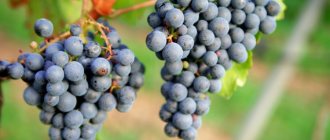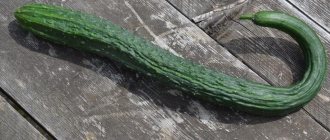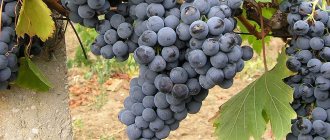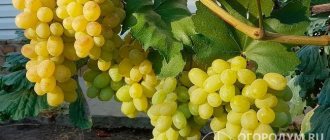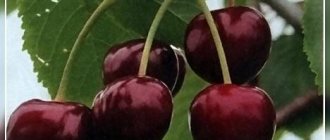Muscat is one of the oldest known grape varieties. Today, a number of muscat varieties and hybrids with different characteristics are known under this name. Grapes are grown both for fresh consumption and for making wine. All varieties have one common feature - the wonderful taste and smell of nutmeg.
Muscats are distinguished by their yield, excellent ripening, and tolerate transportation well. The berries are dense, tasty, with fleshy, juicy pulp. The grapes retain their taste and muscat aroma for up to 2–3 months.
The grapes are native to Central Asia, so they do not tolerate cold well and require a lot of sun to ripen. However, today breeders offer varieties that can withstand significant frosts, are resistant to mildew and sulfur rot and manage to ripen during the short northern summer.
Main varieties
Breeders have developed many hybrids and new varieties. Each of them has a specific purpose in consumption and industrial production. Muscat grapes are considered the best raw materials for winemaking. It is used in wine production - when producing wine, juices at home and on a production scale.
Pink early
It has a bright musky taste and pleasant aroma. The leaves are rich green, the branches are painted red. The brushes have the shape of a cylinder, the weight of which is up to 200 g. The round burgundy berries are sweet in taste and have a thick skin. The early pink bush is endowed with high fruitfulness of shoots (up to 90%) and average but stable yield (ripening is observed after 4 months).
Pleven nutmeg
Pleven nutmeg was developed in Bulgaria. The grapes are early ripening with large clusters (up to 600 g). The oval grapes are endowed with an amber tint, large in size, and sweet in taste. The shoots ripen well (almost 85%). This variety can tolerate temperatures down to -25 degrees.
Summer
Summer is an early variety of muscat grapes; ripe clusters begin to be cut 4 months after the appearance of the ovary.
Features of the variety:
- lush bushes;
- large clusters in the shape of a cylinder or cone (weight - up to 600 g);
- The berries are amber in color and taste sweet and juicy.
Summer Muscat grapes can easily be transported over long distances. It is not susceptible to diseases and pests.
Donskoy
Donskoy is an early ripening variety. Therefore, these grapes are suitable for growing in the Moscow region, the Urals and the North. Small bunches weigh approximately 200 g.
The disadvantage of this variety is its small berries. However, Donskoy produces a consistently high harvest.
It is resistant to low temperatures and diseases that affect Muscat grapes.
Extra early red
This variety is the earliest Muscat grape. Already 3 months after the appearance of the ovary, the first harvest is harvested. The plant has tall bushes. The bunches weigh up to 500 g. Grapes in the shape of balls become red during the ripening process, and ripe berries turn dark purple. Extra early red grapes are used in the production of table wine.
The plant can withstand severe frosts and is immune to various types of rot. This grape variety has one drawback - it is susceptible to powdery mildew.
Livadia
Livadia is an early variety with a short growing season. Medium sized bushes. The shoots ripen well. Since the flowering of this variety is bisexual, one bush is enough for fruiting on the site. It has large branched clusters, slightly loose.
Novoshakhtinsky
Novoshakhtinsky is a mixture of the Talisman variety and very early red Muscat grapes. The fruits become ripe within 3 months after flowering. Capable of self-pollination and has excellent fertility. Large hybrid. One berry weighs about 10 g. The fruits are dark blue in color and covered with a thin skin. The clusters are large, weighing approximately 600 g.
This variety is distinguished from other varieties of nutmeg by its high frost resistance (tolerates temperatures down to -23 degrees). The Novoshakhtinsky hybrid is capable of producing a good harvest. It is transported without damaging the plant. Disadvantage: instability to pests and diseases.
Russian amber
The Russian Yantar plant is very early, matures in about 3-4 months. The clusters contain many juicy, small berries of a light amber hue. After some time, the grapes become larger, lighter and take on an oval shape. One shoot can have more than 3 bunches. Therefore, this variety is one of the most productive. An excellent sweet table wine is made from it.
Hamburg
The Muscat Hamburg grape variety is self-pollinating. The cylindrical or cone-shaped clusters weigh about 400-500 g. Ripening lasts 4.5-5 months. The fruits are oval, black in color with juicy, fleshy pulp and thick skin.
Disadvantages of this variety include poor tolerance to low temperatures, as well as susceptibility to fungal and viral infections. Hamburg grapes are often affected by phylloxera.
Amber
Amber Muscat is a table variety that is used to make desserts, liqueurs and wines. This grape has a pronounced muscat taste. The plant gives a good harvest. The Yantarny variety does not tolerate frosts well (down to -18-19 degrees).
Therefore, it should be well covered with special materials in late autumn.
Prefers warm soil and southern climate. Since the skin of the grapes is dense, the berries can be transported without fear of them cracking.
Far Eastern
Far Eastern is a universal early variety. Has good winter hardiness (up to -30 degrees). The grapes are resistant to insects and diseases. Productivity is above average. The bunch is conical (sometimes branched), small in size, weighing under 100 g.
The disadvantage of the Dalnevostochny variety is its strong smell, which becomes even stronger when the berries gain sugar and the nutmeg intensifies. This attracts different insects.
Noble
The Noble Muscat variety is early ripening. Large berries are yellow-green in color. The pulp has a nutmeg flavor, fleshy and juicy. The skin of the berries is dense. The plant tolerates low temperatures well, produces a bountiful harvest, is resistant to various pests and diseases, and is transported without problems for the integrity of the berries.
Moscow
Moscow grapes are an early ripening table variety. From one bush you can harvest up to 5 kg of crop. The bunch is large, medium in size, weighs about 400 g. The fruits are medium, oval in shape, light green in color. It has a harmonious taste with a hint of nutmeg.
For this variety, crop rationing is necessary. It can be exposed to various diseases and is affected by spider mites up to 60% if preventive spraying is not carried out. The Moscow Muscat variety has winter hardiness down to -25 degrees.
Dievsky
This white muscat table grape variety has a musky aftertaste. When the berries ripen, they turn yellow. One grape weighs about 20 g. The berries are fleshy and juicy, oval in shape.
Dievsky has almost 100% ripening rate. The seedlings easily take root in a new place and grow quickly.
Paradise
This grape is one of the best varieties. It is resistant to pests and various diseases. Large light yellow oval berries weigh up to 10 g. The pulp is sweet, crisp and juicy. The berries are not attacked by wasps. Paradise brings consistently high yields. Suitable for growing in southern regions.
See also
Description and types of diseases and pests of grapes, treatment and control of them
Read
Khrustinka
Khrustinka is a table grape that is eaten fresh or stored, and transported over long distances without problems. The grapes retain their taste for more than 3 months. Medium sized bushes. A bunch of medium density, not very large - up to 600 g. The grapes grow up to 11-15 g, are not subject to cracking and rotting. The berries are crispy, juicy, rich red in color.
Shatilova
The Shatilova variety is white, with large berries, does not require special care, is resistant to pests and diseases, and has high frost resistance. Ideal regions for growing Shatilov are the Urals and Siberia. It produces delicious juices, sparkling Muscat and dessert wines.
Black
This variety is also called Callaba or Kayaba. Optimal growing conditions are warm climates. The grapes are not susceptible to leaf damage or gray rot, but are not resistant to the damage caused by the leaf roller.
Black does not tolerate frost well, is picky about the composition of the soil, and requires timely watering. You also need to ensure that the amount of lime in the soil does not exceed the norm.
Blau
Blau grapes can tolerate low temperatures (down to -39 degrees). Early ripening, with strong immunity, but the yield level is low. This variety should be harvested in mid-September, when the berries become sweeter. Small brushes weigh 300 g. The fruits are black, large (6 g).
Golodrigi
This variety has a table and technical purpose. The ripening period is 4 months. One berry weighs 4-5 g, and a bunch - 300 g. Golodriga grapes are characterized by weak frost resistance (up to -23 degrees). This variety is endowed with excellent taste, disease resistance and abundant yield.
Odessa
The Odessa Muscat grape variety is used for the production of elite juices and dessert wine. Its ripening period is 4-4.5 months. The bunches ripen evenly. The harvest from one bush can reach 5-6 kg. The plant tolerates winter well and can withstand temperatures down to -25 degrees. Suitable soil is sandy loam, loam or black soil. Waterlogged soil is not suitable for growing it.
Dnestrovsky
This variety was bred in Moldova. Medium sized bush. The clusters are large, cone-shaped, weighing 400-500 g. The berries are black, oval or round in shape, with crispy and juicy pulp. Dnestrovsky is a frost-resistant variety that can withstand temperatures down to -25 degrees. The grapes are used to produce semi-sweet and sweet wine.
Darling
Lyubimy grapes have a stable high yield - up to 6 kg are harvested from one plant. The clusters can hang on the bushes for a long time. At the same time, the grapes do not lose their taste. The plant can withstand sub-zero temperatures down to 23 degrees. Muscat grapes Beloved are practically not attacked by wasps.
Codru
The ripening period for this variety is about 4 months. The bushes are small, the bunch is large (600-700 g). The fruits are purple, round in shape, and have a distinct musky odor. This grape is one of the best among Muscats, which is used in the production of dessert wines. Codru is a frost-resistant variety that tolerates temperatures down to -25 degrees. The only drawback is that it is susceptible to gray rot, mildew and phylloxera.
Alexandrian
The Muscat grape of Alexandria produces a high but unstable harvest. The most optimal conditions for good yields are hot climates. The plant can be damaged by leaf rollers, oidium, and mildew. The frost resistance of the Alexandria variety is low. Therefore, it is advisable to grow it in warm places.
Gold
This mid-season variety was bred by American breeders; the harvest is obtained after 4 months. The bunch is large, weighing up to 500 g. Oval berries when ripe are endowed with an amber hue. Golden is considered a universal variety, used both fresh and for the production of dessert wines. The plant produces high and stable yields.
Pridonsky
The Pridonsky variety is distinguished by its medium-late ripening period. The clusters are small, weighing about 250-300 g. The grapes are large in size, round and round-oval in shape.
This variety is capable of producing good yields. It is characterized by high frost resistance (up to -27 ᵒС). In winter it is not necessary to cover. The Pridonsky variety is also resistant to common vineyard diseases.
Crimean
This Crimean muscat variety produces a harvest by mid-September. The clusters are medium in size and cylindrical in shape. The grapes are small, whitish-yellow, oval in shape. The fruit pulp is juicy and fleshy. It has a harmonious nutmeg scent. The skin is strong and dense. The bushes grow large and lush. The yield level is average. The plant is not resistant to fungal diseases. The shoots ripen well. This variety is consumed fresh.
Muscat Massandra
Muscat Massandra is the pearl of Crimean winemaking, one of the best representatives of sweet Muscats in the world, the pride of the royal court of the Russian Empire.
The wine was founded by Prince L. Golitsyn in 1894, the first batch of drinks went to the cellars for aging in 1898. Massandra produces a wide range of wines, including several types of sweet Muscat (White Muscat, Yuzhnoberezhny Muscat, Pink Muscat, Tauride Muscat, White Muscat, Pink and Black, etc.). The aroma of the drink has tones of honey, mountain flowers, roses, and citrus zest; this wine has won several dozen gold medals and won victories at international competitions.
White Muscat of red stone is one of the most popular Massandra wines
In the cellars of the winery there is a collection of bottles that are 60-80 years old. Sometimes Massandra puts several copies up for sale. Despite all the ambiguous attitudes towards wines from the post-Soviet space, Muscat Massandra is known abroad.
Comparative characteristics
To choose a Muscat grape variety, you will need to determine which type is more to your taste and which is suitable for the site. Only after familiarizing yourself with each variety in detail can you make the right choice. For example, if you need grapes for wine production, Amber, Odessa, and Super Early Red are suitable.
Each Muscat grape variety has its own merits. Such as Pridonsky, Golodrigi and Noble are resistant to various diseases and pests. Varieties Alexandrinsky, Black and Yantarny do not tolerate low temperatures. They should be grown in warm regions. And Pridonsky, Novoshakhtinsky and Far Eastern, on the contrary, tolerate sub-zero temperatures well.
What grapes are called muscat?
Muscats are a group of grape varieties that share common characteristics. The varieties are characterized by:
- high sugar content combined with acidity from 19 to 33%;
- characteristic aroma with a tart musky note;
- high yield and large fruit;
- good phytoncidal properties.
The homeland of muscat grapes is Central Asia, but currently varieties of this group are grown in France and Italy, Spain and Crimea. There are table varieties intended for consumption as dessert, and technical varieties - they are used in making wine.
Attention! The disadvantages of muscat varieties include low frost resistance and susceptibility to fungi and pests.
Advantages and disadvantages
Wines made from Muscat grapes have an excellent, rich and pronounced taste. Muscat berries have a beneficial effect on the human body. The fruits contain phytoncides, which have a beneficial effect on the intestines. The Muscat grape variety is endowed with other advantages - the bushes consistently produce a bountiful harvest and look beautiful.
The plant is also endowed with some disadvantages that are associated with its cultivation.
There are nutmeg varieties that prefer only warm climates and do not tolerate very low temperatures. Such grapes must be protected with the help of special means before the onset of winter.
Also, some varieties are not resistant to various infectious and fungal diseases. If not treated in a timely manner, this may affect the yield.
Story
According to one version, the first muscat vines were cultivated 3-5 thousand years ago in Ancient Egypt and Persia. Another theory says that the ancient Romans and Greeks made wine from muscat grapes in the 8th century. BC. However, there is no documentary evidence. Officially, the first mention of nutmeg is found in the works of the Franciscan monk Bartholomew of England in 1230-1240.
The origin of the name is also not entirely clear: the roots of the word muscat can be found in Persian, Greek, French, and Italian. Perhaps the term is related to the word “musk”, or perhaps comes from the Italian mosca (fly), as the powerful aroma of the berries attracts swarms of insects. One theory claims that the grapes are generally named after their place of origin - the Ottoman city of Muscat or the Greek city of Moschato.
Growing Tips
To get a healthy, stable and abundant harvest, it is necessary to carry out proper regular and timely care of the plant. Muscat grapes are not too capricious, but you should not neglect carrying out some agrotechnical measures.
Shelter for the winter
It is imperative to cover unstable varieties, hybrids, young bushes and complex-resistant ones, since it is impossible to guess how temperature conditions will change. Muscat grape varieties that can withstand large temperature changes can be covered for the winter using slate, roofing felt or a tent film shelter.
The most effective method of protecting grapes from frost is complete covering with earth or shields. Thus, the queen cell will be protected. The timing of covering Muscat grapes is different for each region and depends on climatic conditions. Experienced gardeners advise doing this after leaf fall.
Drip irrigation and spraying system
Muscat grapes, like other plants, need regular watering. Water consumption depends on the growing season and development phase. The maximum is observed during the period when the greatest increase in biomass is expected. Water consumption decreases when the growing season ends. Climatic conditions, soil and variety also play a role.
In a small vineyard, it’s easy to make a drip system yourself. To do this, you need a tank or other storage container. Insert pipes into the lower and upper parts of the tank. The top one is designed to supply liquid, and the bottom one is to connect it to the pipeline on which the droppers are located.
Droppers are made from medical systems for intravenous infusions. Insert the needle into the rubber hose and place the free end under the plant. In order for water from the container to flow by gravity to the droppers, it must be placed, secured on a stand, just above the level of the droppers. A height of 100 cm will be sufficient.
conclusions
- Muscat refers to a group of muscat varieties (Rusbol, Rossoshansky, Natukhaevsky, Golodrich, Kishmish, Muskateller/Muskatel, Vostorg, Muscari/Muscaris, Citronny, Solomka, Raspberry), which are distinguished by one common feature: the characteristic taste and smell of muscat.
- In general, nutmeg varieties are very heat-loving and have little resistance to fungal diseases. But thanks to the work of breeders, varieties have been developed that are both frost-resistant (winter and summer) for Siberia, and insensitive to diseases.
- According to the description, any muscat grapes have high taste characteristics: according to the tasting scale, their quality is rated from 7.5 to 9.5 out of 10 possible.
- Most varieties are distinguished by excellent yield, large beautiful berries and a very marketable appearance of the bunches (Hungarian, Odessa, Kuban, Besedochny, Dniester, Shakhty).
- The pulp of the berries is juicy, but fleshy and dense. The grapes tolerate transportation well and are perfectly stored without losing their taste.
- Table muscat grapes are traditionally grown more often on private farms for their excellent taste. Technical varieties represent first-class raw materials for the production of the highest quality wines and sparkling wines.
Read about how to preserve grapes in this article.
How to choose quality seedlings when purchasing
It is recommended to buy summer Muscat seedlings from nurseries or from bona fide sellers with good reviews. Otherwise, the likelihood of purchasing a seedling of a different variety increases. The purchase must be made during the period of mass sales.
During an external inspection, attention should be paid to the following:
- The thickness of the seedling's vine should not be thinner than 0.5 cm, or better yet 0.8–1 cm. Seedlings that are too thick should not be taken either.
- The seedling must be free of traces of disease and pest damage.
- If the container is transparent, then you should carefully examine the roots - they should be well developed, without signs of rot.
- This year's seedling should have from 3 to 5 buds. The buds must be alive and not fall off.
- When buying a seedling with bare roots, you need to cut off the tip of one root with pruning shears. The cut should be light and moist.
- There should be no thickening or dry areas on the roots.
- There is no need to take seedlings with roots as thin as a spider's web.
- Seedlings must be at least 30 cm long.
- Annual seedlings take root best.
Important! When planted in the fall, the seedlings should no longer have leaves, and in the spring they should have at least 4 green leaves.
Landing rules
After purchasing a grape seedling of the Muscat summer variety, it must be planted correctly.
When is the best time to plant
Grape seedlings can be planted in spring and autumn. Each landing option has its own advantages and disadvantages. Many people prefer autumn planting - at this time there is the greatest selection of planting material, and it takes root well, but may suffer from early frosts if it has not yet been protected. Planting is carried out from October until frost. Such a seedling is carefully protected from the cold.
Usually, young seedlings are covered with plastic bottles with holes for ventilation, and before the onset of frost they are covered with sawdust, peat, pine needles or just earth. If the seedling was purchased after the onset of frost, then it is necessary to ensure its safety in the basement until spring planting.
In spring, in the second half of April or early May, annual seedlings that are already woody are planted. When planting, the soil should already warm up to +10°C. Green seedlings are planted from the end of May, when the threat of a return of cold weather has completely passed. Such plants take root well by autumn and tolerate wintering better.
We recommend reading how to choose the most delicious grape variety.
Where to plant on the site
The place for grapes should be well lit by sunlight and free from drafts. This plant is planted at a distance of 2–3 m from fruit trees and at the same time 0.5–0.8 m away from the asphalt road. The seedling can be placed on the south side of the buildings, retreating 1 m from them, so that the roots do not destroy the foundation.
The vigorous variety Summer Muscat requires a lot of space for nutrition (3–5 m²), and the height of the trellises will be 2–3 m. You can use an arch, gazebo, or wall for supports. The soil for the vineyard should be well permeable and nutritious and in no case waterlogged.
How to plant
Planting holes for this vigorous variety are dug at a distance of 2 m from each other in a row and at row spacing of 3 m. They begin to dig several weeks before planting and are made with dimensions of 80 × 80 × 80 cm. When digging, the top fertile layer is folded separately, and then before planting, mix with manure (2-3 buckets) and ash. Half a kilogram of superphosphate is also added to them. Then this soil mixture is placed at the bottom of the hole and watered well. Sand is added to clay soil, and if the soil is sandy, then a hole is dug 25 cm deeper and a layer of crushed stone (10 cm) and clay (15 cm) is poured onto the bottom.
Important! Groundwater should be no closer than 1.5 m to the surface of the earth.
Before planting, the seedling is soaked in water, in which it is recommended to dissolve root formation stimulants. Then a fertile layer is placed at the bottom of the hole and a seedling is placed on it “heel” at a depth of 0.5 m. Next, the infertile layer is filled in, watered and trampled down. If necessary, the seedling is covered with soil until it grows. Only the planted seedling is watered 2-3 times every week, pouring a couple of buckets of water into the hole. When planting in autumn, they provide protection from the cold.





